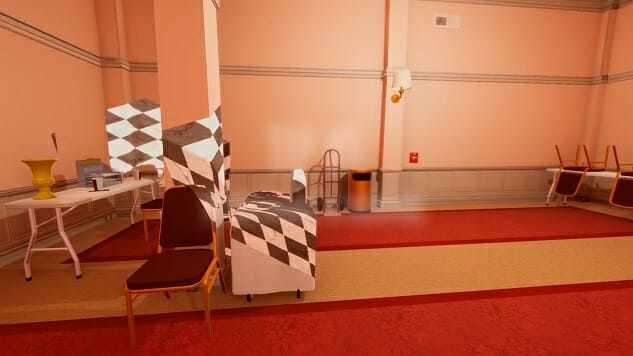Set within an experimental dream therapy program, Superliminal uses forced perspective in the solutions to its environment puzzles. While progression often relies on the player’s ability to navigate optical illusions, the player also has to negotiate the size of the items in the immediate surroundings by using their field of view. For example, in one early challenge, the door to the next room is positioned high on the wall, and a small wedge of cheese must be pivoted until it’s large enough to act as a ramp. However big the object appears when you pick it up or when you drop it will affect its actual size; to make it larger, you can reposition it until it takes up most of the screen. To make it smaller, simply pick it up from far away. The approach is unique in that it asks the player to rethink the rules of reality, instead of simply viewing each puzzle as a lock and key.
This object manipulation, combined with the game’s fluid progression and heavy use of optical illusions, mirrors an appropriate sense of “dream logic.” Playing Superliminal feels like walking through the improbable but connected events you’d experience in a dream. But the game also feels like an escape room disguised as an office, which is fitting, given that offices are the boring, repetitive sort of place where no one ever really wants to be. The most delicious moments of the game are those spent outside the bounds of the testing facilities, peeping at the hallways that connect the sets and the building materials abandoned in the corridor’s forgotten corners. The artificiality of the player character’s on-rails experience, and the goal to use spontaneous problem solving skills to defy the illusory boundaries of that space, creates the sense that you’re breaking the rules by thinking outside the box. But it also asks you to wonder if that was the plan all along. The question of just how forbidden your independence really is supports the game’s themes of lucid dreaming. After all, when you wake from a lucid dream, you can never really be sure if you were really controlling your dream, or not.
Sometimes to cure your burnout, you need a few small wins, and the puzzles of Superliminal have recharged my batteries. It has that bits and pieces progression that makes it satisfying to pick up for a few minutes, and then put down once you’ve solved a room or two. It’s been a great palette cleanser following the busy holiday season as I wrap up the last of 2019. I urge you to not…sleep on this game.
Holly Green is the assistant editor of Paste Games and a reporter and semiprofessional photographer. She is also the author of Fry Scores: An Unofficial Guide To Video Game Grub. You can find her work at Gamasutra, Polygon, Unwinnable, and other videogame news publications.
